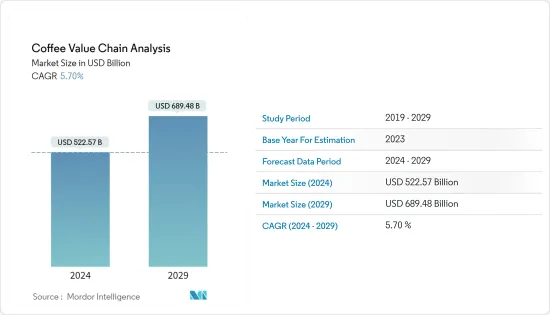
|
市場調査レポート
商品コード
1443969
コーヒーのバリューチェーン分析:市場シェア分析、業界動向と統計、成長予測(2024-2029年)Coffee Value Chain Analysis - Market Share Analysis, Industry Trends & Statistics, Growth Forecasts (2024 - 2029) |
||||||
カスタマイズ可能
適宜更新あり
|
|||||||
| コーヒーのバリューチェーン分析:市場シェア分析、業界動向と統計、成長予測(2024-2029年) |
|
出版日: 2024年02月15日
発行: Mordor Intelligence
ページ情報: 英文 70 Pages
納期: 2~3営業日
|
全表示
- 概要
- 目次
コーヒーの市場規模は2024年に5,225億7,000万米ドルと推定され、2029年までに6,894億8,000万米ドルに達すると予測されており、予測期間(2024年から2029年)中に5.70%のCAGRで成長します。

主なハイライト
- コーヒーは南米、アフリカ、アジアの50以上の新興諸国で生産されており、世界中の2,000~2,500万以上の世帯にとって不可欠な収入源です。コーヒー豆の最初の生産は非常に労働集約的です。それには、農業、収集、加工など、いくつかの労働集約的な活動が含まれます。したがって、これらの活動は労働力が豊富な国で行われます。しかし、焙煎とブランディングはコーヒーのサプライチェーンにおいて資本集約的な活動であるため、北部の先進国に集中しています。バリューチェーンの構造は、生産国と消費国に非常に似ています。コーヒーのバリューチェーンは、栽培、加工、焙煎、消費という4つの主要な段階で構成されます。プロセスの各段階には環境、社会、経済、ガバナンスの問題があり、コーヒー豆抽出の将来の持続可能性に影響を与えます。
- 消費者面では、政府によるコーヒーの宣伝と大手企業による研究開発への投資が、予測期間中の市場の成長を刺激すると予想されます。たとえば、2022年4月、サウジアラビア王国のLulu Hypermarket は、文化省と協力して、サウジアラビア産コーヒーの料理的および文化的重要性への注目を集めるための素晴らしいプロモーションである「2022年サウジコーヒー年」を開始しました。豆はサウジアラビアのおもてなしの象徴としての独特の伝統的かつ象徴的なものです。
- しかし、コーヒー産業は農園から市場に至るまで、劣悪な労働慣行、不公平な賃金、森林破壊、焙煎工場による大気汚染、コーヒーの変則的な価格設定など、さまざまな問題を抱えており、市場の障壁となっています。
コーヒーのバリューチェーン市場動向
認証コーヒー製品の需要の急増
世界の主要国では、認証コーヒー、特にフェアトレードコーヒーが大幅に成長しています。この開発は、コーヒーの生産と流通に伴う社会、環境、健康への影響に関する消費者の懸念から生まれました。持続可能な認証により、消費者はコーヒーなどの必需品を毎日購入する際に、より公正で健康的な環境に対する好みを表明できるようになります。
コーヒーの調達と品質に対する消費者の関心の高まりにより、認証コーヒーの需要が世界的に増加しています。認証されたコーヒーは、製品の信頼性を消費者に保証します。これらの認証は、コーヒーの調達と品質に対する消費者の関心の高まりを受けて、環境に配慮した農業慣行とコーヒー生産時の品質に関して消費者にさまざまな第三者保証を提供します。
いくつかのコーヒー認証機関がコーヒーの生産手順とサプライチェーンを検査しています。その中には、フェアトレード認証、レインフォレスト・アライアンス認証、UTZ認証、USDAオーガニック認証などがあります。これらの認証は、労働者の生活の質を向上させ、認証コーヒーの取引の増加を通じて適切な市場アクセスを獲得するのに役立ちます。
すべての認証の中でも、農家が地域社会と環境に配慮しながら専門的にコーヒーを栽培できるようにするには、UTZ認証または熱帯雨林同盟が必要です。 UTZ認証プログラムの最も重要な側面はトレーサビリティです。これは、消費者が自分のコーヒーがどこから来たのか、どのように生産されたのかを正確に知ることができることを意味します。これにより、消費者は認証コーヒーを購入する傾向が高まり、予測期間中の市場の成長を促進します。
ブラジルがコーヒー生産の頂点に立つ
ブラジルは熱帯地域に位置しており、コーヒーの生産に非常に適しています。国連食糧農業機関(FAO)が公開したデータベースによると、ブラジルのコーヒー生産量は2019年に301万トンだったが、2020年には22.9%(370万トン)まで増加しました。ブラジルのコーヒー収穫総面積は、2019年と2020年にそれぞれ1,825,283ヘクタールと1,898,239ヘクタールと記録されました。
さらに、ITC貿易マップによると、2021年にはブラジルが228万8,336トンを占める最大のコーヒー輸出国で、次いでベトナム、ブルキナファソ、コロンビア、ドイツが続きました。
この国は真のコーヒー生産大国です。ブラジルは世界のコーヒー供給量の約40%を生産しており、太古の昔から世界のコーヒー市場の主要なプレーヤーでした。さらに、ブラジルの多くの地域はコーヒー栽培に最適な気候に恵まれています。コーヒー農園はブラジルの約27,000平方キロメートルに及び、その大部分はミナスジェライス州、サンパウロ、パラナ州にあります。また、この国は近年、南東部の山岳地帯ミナス地方の集中生産地から中部の温暖なセラード地方への領土の移転も目の当たりにしています。収穫時期は4月から9月で、気温がコーヒー豆の栽培に最適な時期です。
コーヒーのバリューチェーン業界の概要
その他の特典
- エクセル形式の市場予測(ME)シート
- 3か月のアナリストサポート
目次
第1章 イントロダクション
- 調査の前提条件と市場の定義
- 調査範囲
第2章 調査手法
第3章 エグゼクティブサマリー
第4章 サプライチェーン分析
- サプライチェーンの構造
- サプライチェーンの利害関係者
- サプライチェーンの構造問題
第5章 バリューチェーン分析
- バリューチェーンの構造
- バリューチェーンの価格値上げ
- バリューチェーンの利害関係者
- バリューチェーンの構造問題
第6章 市場機会と将来の動向
The Coffee Market size is estimated at USD 522.57 billion in 2024, and is expected to reach USD 689.48 billion by 2029, growing at a CAGR of 5.70% during the forecast period (2024-2029).

Key Highlights
- Coffee is produced in more than 50 developing countries in South America, Africa, and Asia and is an essential source of income for more than 20-25 million families worldwide. The initial production of coffee beans is highly labor intensive. It involves several labor-intensive activities, such as farming, collecting, and processing. Hence, these activities are performed in labor-abundant countries. However, roasting and branding are capital-intensive activities in the coffee supply chain and are therefore situated in the northern industrialized countries. The structure of the value chain is very similar to producing as well as consuming countries. The coffee value chain comprises four main phases: cultivation, processing, roasting, and consumption. Each step in the process has environmental, social, economic, and governance issues that affect the future sustainability of extracting coffee beans.
- On the consumer front, the promotion of coffee by the government, coupled with investment in R&D by major companies, is expected to stimulate the market's growth during the forecast period. For instance, In April 2022, Lulu Hypermarket in the Kingdom of Saudi Arabia, in cooperation with the Ministry of Culture, launched the Year of Saudi Coffee 2022, a great promotion meant to draw attention to the culinary and cultural significance of Saudi-grown coffee beans and it's unique traditional and symbolism as a marker of Saudi hospitality.
- However, the coffee industry has various issues, from farms to markets, such as poor labor practices, unfair wages, deforestation, air pollution from roasting plants, and irregular pricing of coffee, acting as a barrier to the market.
Coffee Value Chain Market Trends
Surge in Demand for Certified Coffee Products
Considerable growth has occurred in certified coffee, especially in fair trade coffee, in major countries globally. The development comes from consumer concerns related to social, environmental, and health impacts associated with the production and distribution of coffee. Sustainable certifications allow consumers to express preferences for a more just and healthier environment with daily purchases of essential commodities, like coffee.
Due to rising consumer concerns regarding the sourcing and quality of coffee, the demand for certified coffee is increasing globally. Certified coffee is an assurance to the consumer about the product's reliability. These certifications offer various third-party guarantees to the consumer regarding environmental-friendly farming practices and the quality involved during the production of coffee due to rising consumer concerns regarding the sourcing and quality of coffee.
Several coffee certification organizations are checking coffee's production procedures and supply chain. Some of them are Fair Trade Certification, Rainforest Alliance Certification, UTZ Certification, and USDA Organic Certification. These certifications help to improve the quality of life of workers and help to gain adequate market access through increased trade of certified coffee.
Among all the certifications, UTZ Certification or the rainforest alliance is necessary, allowing the farmers to grow coffee professionally with care for local communities and the environment. The most important aspect of the UTZ certification program is traceability, which means that consumers can know exactly where their coffee comes from and how it was produced. This makes consumers more inclined toward purchasing certified coffee, fueling the market's growth during the forecast period.
Brazil Dominates the Production of Coffee
Brazil is appropriately nestled in the tropical zone, which is highly suitable for the production of coffee. According to a database published by United Nations Food and Agriculture Organization (FAO), coffee production in Brazil stood at 3.01 million metric ton in 2019 and it has increased to 22.9% in 2020 (3.70 million metric ton). The total area under coffee harvest in Brazil was recorded at 1,825,283 and 1,898,239 hectares for 2019 and 2020 respectively.
Furthermore, as per the ITC Trade map, Brazil was the largest exporter of coffee in the year 2021 accounting for 2,288,336 metric ton, followed by Vietnam, Burkina Faso, Colombia, and Germany respectively.
The country is a true powerhouse of coffee production. Brazil produces nearly 40% of the world's coffee supply and has been a key player in the global coffee market since time immemorial. Furthermore, many areas in Brazil have a climate perfectly conducive to coffee farming. Coffee plantations cover about 27,000 square kilometers of Brazil, with the majority located in Minas Gerais, Sao Paulo, and Parana. The country has also been witnessing a territorial shift from a concentrated production in the mountainous Minas region in the Southeast to the Central warmer Cerrado region in recent years. The harvest period ranges from April to September, as the temperature is optimal for the cultivation of coffee beans during this period.
Coffee Value Chain Industry Overview
Additional Benefits:
- The market estimate (ME) sheet in Excel format
- 3 months of analyst support
TABLE OF CONTENTS
1 INTRODUCTION
- 1.1 Study Assumptions and Market Definition
- 1.2 Scope of the Study
2 RESEARCH METHODOLOGY
3 EXECUTIVE SUMMARY
4 Supply Chain Analysis
- 4.1 Supply Chain Structure
- 4.2 Stakeholders in the Supply Chain
- 4.3 Issues with Supply Chain Structure
5 Value Chain Analysis
- 5.1 Value Chain Structure
- 5.2 Price Markups in the Value Chain
- 5.3 Stakeholders in the Value Chain
- 5.4 Issues with Value Chain Structure

